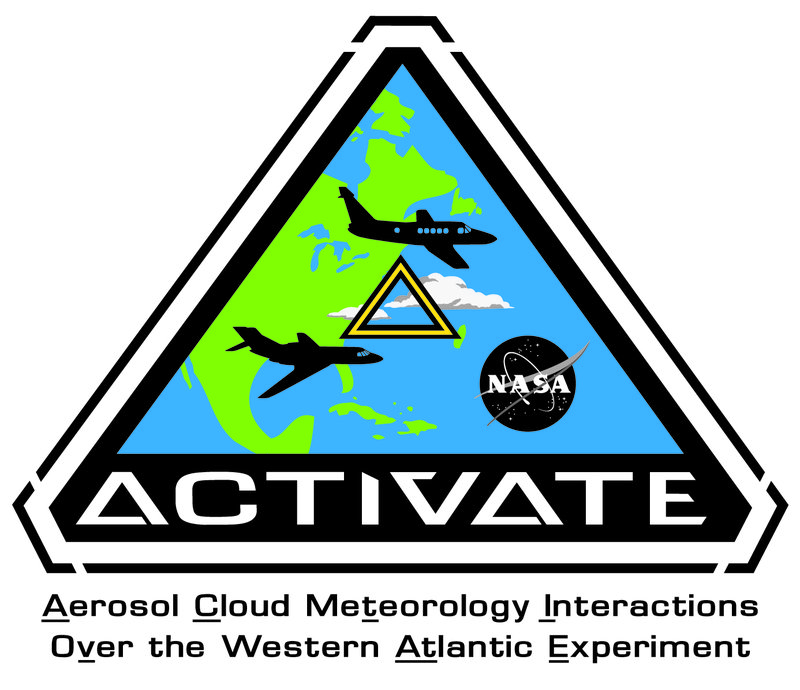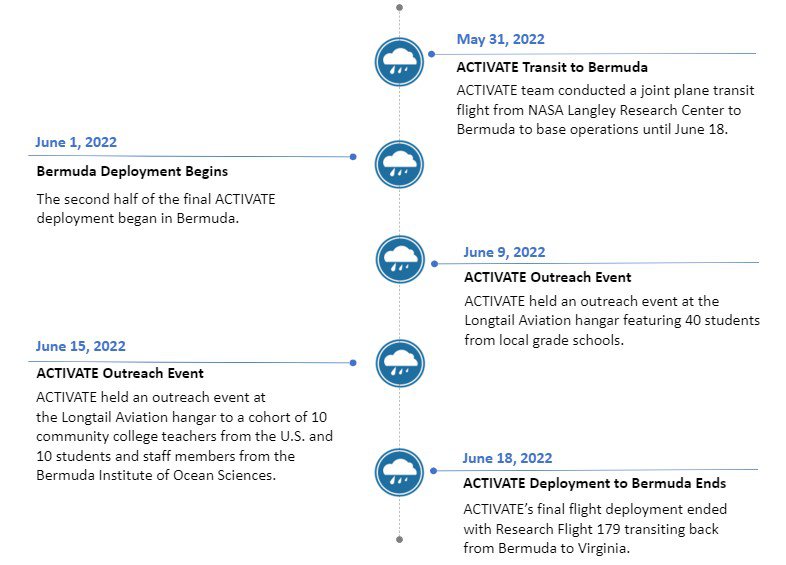ACTIVATE Travels to Bermuda
ACTIVATE Travels to Bermuda
The Aerosol Cloud meTeorology INteractions oVer the western Atlantic Experiment (ACTIVATE) provides much needed knowledge on the relationships between aerosols and clouds. Expanding this knowledge is crucial in understanding the different cloud properties and their resulting impact on climate and weather. Throughout the campaign, two aircraft were deployed: the King Air, and the HU-25 Falcon to conduct "statistical surveys" over the northwestern Atlantic Ocean. The King Air was equipped with remote sensing instrumentation and dropsondes, while the HU-25 was equipped with an in-situ payload for measurements of aerosol, cloud properties, trace gases, and meteorological parameters. The dual aircraft approach allowed for more comprehensive characterization of aerosol and cloud properties in a single atmospheric column at the same time. Both aircraft operated on the same flight path but flew at different altitudes. The King Air flew at ~9km, and the HU-25 flew in the lower troposphere (<3km) where boundary layer clouds evolve. ACTIVATE was a six-deployment Earth Venture Suborbital-3 (EVS-3) mission with the final half of the sixth deployment based out of L.F. Wade International Airport, located in St. George's Parish Bermuda.


Image Source:
NASA/ACTIVATE
Spatial Coverage:
(25°–50°N, 60°–85°W)
Temporal Coverage:
June 1-18, 2022
Scientific Objectives
- Quantify relationships between number concentrations of aerosols (Na), cloud condensation nuclei (CCN), and cloud droplets (Nd) and reduce uncertainty in model cloud droplet activation parameterizations.
- Expand process-level understanding and model representation of factors controlling cloud properties and their relationships with cloud effects on aerosol.
- Improve remote sensing capabilities in the retrieval of aerosol and cloud properties that related to aerosol-cloud interactions.
Instruments Used
Two aircraft, the HU-25 Falcon and the King Air, were used to collect data for ACTIVATE. Each aircraft was equipped with an extensive suite of instrumentation detailed in the table below.
| Platform Type | Platform | Relevant Instrument | Study Area |
|---|---|---|---|

|
1. TSI Condensation Particle Counters TSI Scanning Mobility Particle Sizer (SMPS) TSI Laser Aerosol Sizer (LAS) TSI Nephelometer (TSI Neph) f(RH) System: TSI 3563 Nephelometers and RH Controlled Humidifier Particle Soot Absorption Photometer (PSAP) Particle Into Liquid Sampler (PILS) High-Resolution Time-of-Flight Aerosol Mass Spectrometer (AMS) 2. DMT Cloud Condensation Nuclei Spectrometer (CCN) DMT Cloud Droplet Probe (CDP) and Cloud and Aerosol Spectrometer (CAS) DMT Cloud Imagery Probe (CIP) Axial Cyclone Cloud water Collector and offline chemistry (AC3) 3. Turbulent Air Motion Measurement System (TAMMS) Rosemount Total Temperature Sensor 102 (TTS) IR Sensor for Sea Surface Temperature KT-15 Diode Laser Hygrometer (DLH) Edgetech frostpoint Hygrometer (cryo) 4. PICARRO Cavity Ring-Down Spectrometer 2B Technologies Ozone Monitor 5. Applanix POS AV |
1. Aerosol properties 2. Cloud properties 3. Meteorological state parameters 4. Trace gases 5. Aircraft geolocation and attitude parameters |
|

|
King Air |
1. High Spectral Resolution Lidar 2 (HSRL-2) Research Scanning Polarimeter (RSP) 2. Dropsondes 3. Applanix POS AV |
1. Aerosols and cloud properties 2. Atmospheric profiling 3. Aircraft parameters |
Access Data
The ASDC archives and distributes all currently available publication-quality data for ACTIVATE. Data from ACTIVATE can be accessed on the ASDC ACTIVATE landing page, SOOT, as well as on Earthdata Search.
Events of Interest
This section highlights events within the field campaign of particular scientific interest.

To make up for not flying there early in the campaign, the ACTIVATE team conducted a joint plane transit on 31 May 2022 from NASA’s Langley Research Center to L.F. Wade International Airport to conduct science flights farther out over the Atlantic Ocean. Deploying out of Bermuda allowed ACTIVATE researchers to take measurements that were less affected by emissions from East Coast cities and the differences in sea surface temperatures caused by the Gulf Stream. The first series of flights conducted through Sunday, June 5, 2022, helped obtain statistics of atmospheric conditions around Bermuda. Many of the local Bermuda flights ended with a spiral sounding offshore the Tudor Hill facility which allowed for the aircraft to obtain vertical data for trace gases, aerosol, and weather parameters that complement extensive surface monitoring work. This surface monitor work was conducted in coordination with the NSF-funded BLEACH project focusing on halogen chemistry.
During the second week of flights, there was evidence of African dust in the region that the aircraft sampled. On June 9, 2022, the ACTIVATE team hosted a successful outreach event at the Longtail Aviation hangar featuring 40 students from three local grade schools, in addition to 6 students and staff from the Bermuda Institute of Ocean Sciences, staff from the Bermuda Civil Aviation Authority, and the US Consular General. As part of the event, ACTIVATE team members gave tours of both aircraft and talked to the guests and students about the science instrumentation and goals of the mission. Outreach has been an integral part of ACTIVATE, and this event was a unique opportunity to engage with students and get them inspired about science. Due to the success of this event, a second outreach event was conducted in the same hangar on June 15, 2022 with a cohort of U.S. community college teachers.
During the last week of the Bermuda deployment, several flights continued to build on the dataset for aerosol-cloud-meteorology interactions surrounding the Bermuda area. One highlight was a joint research flight synchronized with a CALIPSO overpass in conditions that were ideal for intercomparisons of data, including cloud-free air with significant aerosol concentrations and diverse aerosol types (including African dust). The ACTIVATE deployment concluded June 18, 2022, with Research Flight 179 returning to Virginia from Bermuda, and now the ACTIVATE team is focusing on analysis of the full three years of archived data.
Source: https://www.nasa.gov/feature/langley/nasa-airborne-science-mission-engages-with-students-in-bermuda
Relevant Publications
ACTIVATE AGU Presentations:
Cairns, B., Alexandrov, M., van Diedenhoven, B., Crosbie, E., Hu, Y., Scarino, A. J., Shook, M., orooshian, A., Hair, J., Sinclair, K., Wasilewski, A., Hostetler, C., Moore, R., Shingler, T., & Ziemba, L. (2020). Using remotely sensed cloud top properties to look at drizzle formation [Conference presentation]. AGU Fall Meeting 2020, virtual location. https://agu.confex.com/agu/fm20/meetingapp.cgi/Paper/734416
Ferrare, R., Hair, J., Hostetler, C., Harper, D., Seaman, S., Shingler, T., Cook, A., Vaughan, M., Diskin, G., DiGangi, J., Nowak, J., Moore, R., Ziemba, L., Winker, D., Shook, M., Fenn, M., Scarino, A. J., Crosbie, E., Thornhill, K. L., Robinson, C., Choi, Y., Liu, H., Zhang, B., Choi, H., Zuidema, P., Chellappan, S., Schlosser, J., & Sorooshian, A. (2020). Airborne HSRL2 Measurements of Enhanced Depolarization in Marine Aerosols [Poster presentation]. AGU Fall Meeting 2020, virtual location. https://agu2020fallmeeting-agu.ipostersessions.com/?s=E1-00-53-9D-21-AF-20-46-58-6F-11-D6-D8-73-E4-B7
Sorooshian, A., & ACTIVATE Science Team (2020). The Aerosol Cloud meTeorology Interactions over the western ATlantic Experiment (ACTIVATE): Concept and First Results [Poster presentation]. AGU Fall Meeting 2020, virtual location. https://agu2020fallmeeting-agu.ipostersessions.com/default.aspx?s=C6-ED-07-8E-69-B8-47-AB-67-86-88-24-4B-69-13-CD
Chellappan, S., Zuidema, P., Painemal, D., Li, X., Wang, H., Thornhill, K. L., Robinson, C., Chen, G., Shook, M., & Sorooshian, A. (2020). Investigating Cold Air Outbreaks over the Western North Atlantic Ocean [Poster presentation], AGU Fall Meeting 2020, virtual location. https://agu2020fallmeeting-agu.ipostersessions.com/?s=1D-68-D2-BA-D3-CD-13-9B-3F-10-13-99-A2-8C-84-EC
Li, X., Wang, H., Ackerman, A. S., Cairns, B., Chellappan, S., Chen, G., Chen, J., Crosbie, E., Endo, S., Ferrare, R. A., George, G., Hair, J.W., Kirschler, S., Kleb, M. M., Moore, R., Painemal, D., Scarino, A. J., Shook, M., Shingler, T. J., Sorooshian, A., Thornhill, K. L., Tornow, F., Voigt, C., Zeng, X., & Zuidema, P. (2020). Large-eddy Simulations of Marine Boundary-layer Clouds during the ACTIVATE Campaign: Sensitivities to Large-scale Forcings [Poster presentation], AGU Fall Meeting 2020, virtual location. https://agu2020fallmeeting-agu.ipostersessions.com/?s=9D-AD-84-6F-1F-8E-E0-D9-11-7D-06-C1-D9-20-4A-D5
Tornow, F., Ackerman, A. S., Fridlind, A. M., Cairns, B., Crosbie, E., Kaufmann, S., Kirschler, S., Li, X., Moore, R., Robinson, C. E., Shingler, T. J., Shook, M., Sorooshian, A., Thornhill, K.L., van Diedenhoven, B., Voigt, C., Wang, H., Winstead, E., & Ziemba, L. D. (2020). Cold air outbreaks during ACTIVATE: Observationally constrained large-eddy simulations of microphysically-mediated cloud regime transitions [Poster presentation], AGU Fall Meeting, 2020, virtual location. https://agu2020fallmeeting-agu.ipostersessions.com/?s=E3-93-E2-90-BB-E8-D2-89-C7-1B-FE-8B-BD-3C-D7-59
Liu, H., Zhang, B., Moore, R., Ziemba, L., Choi, H., Painemal, D., Wang, H., Sorooshian, A., Hair, J., Ferrare, R., Crosbie, E., Shook, M., Scarino, A. J., Fenn, M., Hostetler, C., Chen, G., Kleb, M., Fairlie, D., Luo, G., Yu, F., Tackett, J., Vaughan, M., Diskin, G., Nowak, J., & DiGangi, J. (2020). Distribution and Sources of Tropospheric Aerosols Over the Western North Atlantic During ACTIVATE [Poster presentation], AGU Fall Meeting 2020, virtual location. https://agu2020fallmeeting-agu.ipostersessions.com/?s=F7-7B-44-7B-A2-3C-4A-9A-73-7E-97-1F-9B-8C-4B-F6
Dixon, R. D., Zhang, S., Zeng, X., Wan, H., & Holland, M. (2020). Extreme supersaturation in CESM2 and E3SM simulations: sensitivity to time-stepping and impact on model climate [Poster presentation], AGU Fall Meeting 2020, virtual location. https://agu2020fallmeeting-agu.ipostersessions.com/?s=94-D2-82-BD-53-F6-3A-97-B3-EA-8E-BB-98-78-33-44
Brunke, M. A., Dixon, R. D., Cutler, L., Zeng, X., Sorooshian, A., & Thornhill, L. (2020). Evaluating the Roles of Dynamics, Physics, and Dynamics-Physics Interactions in CAM6 Simulated Clouds and Aerosols over the Western North Atlantic Ocean [Poster presentation]. AGU Fall Meeting, 2020, virtual location. https://agu2020fallmeeting-agu.ipostersessions.com/?s=A6-80-EC-C1-6C-AB-26-D8-15-17-A0-19-F4-02-3F-3D
Ouyed, A., Zeng, X., Longtao, W., Posselt, D., & Su, H. (2020). Two-Stage Artificial Intelligence Algorithm for Calculating Atmospheric Motion Vectors [Poster presentation]. AGU Fall Meeting 2020, virtual location. https://agu2020fallmeeting-agu.ipostersessions.com/?s=57-22-B5-25-7D-83-89-B9-76-44-4A-93-1C-15-48-ED